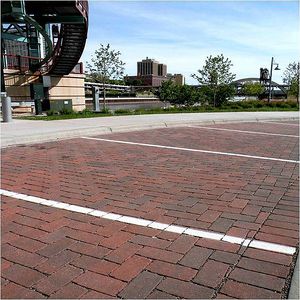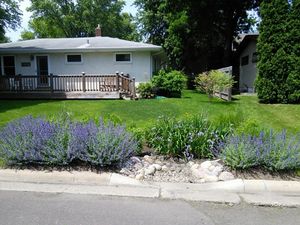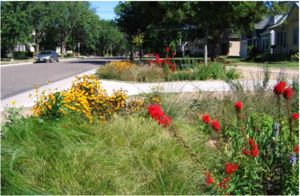
Green Infrastructure benefits of infiltration practices
Infiltration is the practice of draining water into soils, typically through engineered systems such as bioinfiltration (rain gardens), infiltration basins, dry swales with check dams, and permeable pavement. The practice of infiltration is beneficial for soils, maintaining natural hydrology, and has a significant water quality impact for downstream lakes, rivers, and ponds. Depending on design, stormwater infiltration practices can be a key component of green infrastructure (GI) to promote the health and well-being of animals, vegetation, and the people that rely upon these waters when designing sites.
Some of the more common infiltration practices include
- Permeable pavement
- Tree trench/tree box
- Bioretention - bioinfiltration
- Note: Bioretention practices are often called Rain Gardens
- Infiltration - this links to the following practices
- Infiltration trench, including dry wells
- Infiltration basin
- Underground infiltration
- Dry swale (Grass swale)
- High-gradient stormwater step-pool swale
For further reading on different types of infiltration, see Stormwater infiltration Best Management Practices and BMPs for stormwater infiltration.
Contents
Green infrastructure and multiple benefits
Green infrastructure (GI) encompasses a wide array of practices, including stormwater management. Green stormwater infrastructure (GSI) encompasses a variety of practices primarily designed for managing stormwater runoff but that provide additional benefits such as habitat or aesthetic value.
There is no universal definition of GI or GSI (link here for more information). Consequently, the terms are often interchanged, leading to confusion and misinterpretation. GSI practices are designed to function as stormwater practices first (e.g. flood control, treatment of runoff, volume control), but they can provide additional benefits. Though designed for stormwater function, GSI practices, where appropriate, should be designed to deliver multiple benefits (often termed "multiple stacked benefits". For more information on green infrastructure, ecosystem services, and sustainability, link to Multiple benefits of green infrastructure and role of green infrastructure in sustainability and ecosystem services.
| Benefit | Effectiveness | Notes |
|---|---|---|
| Water quality | Most pollutants are retained in the engineered media, soil, or vadose zone. If transported to groundwater, concentrations of most pollutants are below water quality standards. Chloride is an exception. | |
| Water quantity/supply | Can provide effective flood control for small- and medium-intensity storms. | |
| Energy savings | ||
| Climate resiliency | Flood control. Impacts on carbon sequestration are uncertain. | |
| Air quality | ||
| Habitat improvement | Use of perennial vegetation and certain media mixes promote invertebrate communities, pollinators, birds, and potentially small mammals. | |
| Community livability | When vegetation is incorporated, aesthetically pleasing and can be incorporated into a wide range of land use settings. | |
| Health benefits | ||
| Economic savings | Generally provide cost savings vs. conventional practices over the life of the practice. | |
| Macroscale benefits | Macroscale effects depend on the size of the practice. Some infiltration practices, typically underground or tree trench systems, can be very large and have macroscale benefits. | |
| Level of benefit: ◯ - none; ◔ - small; ◑ - moderate; ◕ - large; ● - very high | ||
Green Infrastructure benefits of infiltration practices
- Water quality: Stormwater infiltration practices are excellent water quality treatment practices. Engineered media, soils, and the underlying vadose zone provide effective retention of most pollutants (see Minimum bioretention soil media depths recommended to target specific stormwater pollutants). Chloride and nitrate are exceptions, though concentrations of these are generally below water quality standards except for chloride during deicing season. Infiltration should be avoided in areas where contaminants in soil or groundwater may be mobilized by infiltrating water. For more information, see Surface water and groundwater quality impacts from stormwater infiltration
- Water quantity and hydrology: Infiltration practices reduce the volume of stormwater runoff and retard peak flow from rainfall events, thus reducing flood potential in areas downstream of the practice. They are most effective for small- and medium-intensity rain and runoff events unless sized to meet larger events. Infiltration promotes groundwater recharge, potentially increasing baseflow and/or recharge of deeper aquifers.
- Energy savings: Larger infiltration practices that incorporate trees and provide shade reduce air conditioning costs. Since infiltration reduces stormwater runoff, they help prevent road deterioration and reduce maintenance costs (Using Trees and Vegetation to Reduce Heat Islands;US EPA).
- Air quality: Benefits of infiltration practices are largely indirect, such as sequestration of carbon and other greenhouse gasses. Carbon sequestration is generally insignificant unless vegetation is incorporated into the practice and the soil or engineered media promotes biologic activity.
- Climate resiliency: Properly installed infiltration practices reduce the impact of flooding during rainfall events, particularly small- and medium-sized events. Vegetated infiltration systems promote photosynthesis and carbon sequestration. Incorporation of larger plants such as trees or vegetation that provides shade reduces effects of heat islands (Using Trees and Vegetation to Reduce Heat Islands;US EPA).
- Habitat improvement: Infiltration results in decreased runoff and erosion, which increases soil stability. This promotes vegetation growth that further stabilizes a site and creates habitat for birds, pollinator insects, and potentially small mammals. Soil or media may be engineered to promote invertebrate activity. Reduced runoff associated with increased infiltration reduces adverse effects of elevated temperatures that harm coldwater organisms.
- Community livability: Infiltration that results in groundwater recharge and improved baseflow provides increased recreational opportunities and helps ensure safe and healthy access to water sources. Incorporating aesthetically pleasing landscaping when planning infiltration systems may help improve mental health of the site users (What are the physical and mental benefits of gardening? - Michigan State University Extension). Large infiltration practices that incorporate trees into the design provide shade that can reduce air temperatures (Reducing Urban Heat Islands: Compendium of Strategies: Trees and Vegetation; EPA).
- Health benefits: Infiltration provides cleaner waterways through the reduction of nutrients, pathogens, metals, TSS, and phosphorus and provides healthier environments to the humans, wildlife, and vegetation that use these waters.
- Economic benefits and savings: In addition to water quality and flood control benefits (Braden and Johnston, 2004), properly designed infiltration can prevent downstream cleanup costs. Well maintained infiltration systems combined with vegetation may increase property aesthetics and property value. Properly designed and functioning infiltration systems reduce downstream infrastructure costs (Braden and Johnston, 2004).
Design considerations
Maximizing specific green infrastructure (GI) benefits of constructed areas requires design considerations prior to installation. While site limitations cannot always be overcome, the following recommendations for a designer are given to maximize the GI benefit. In addition to the following information, many design considerations applicable to bioretention should be considered for infiltration practices.
- Water quality
- Follow appropriate design guidance to maximize capture of runoff. Consider local climate characteristics (Gonzalez-Meler et al., 2013), which may affect the type and design characteristics of a practice.
- Design infiltration basins to minimize short-circuiting that results in water bypassing the treatment zones in the practice. Deep macropores may lead to short-circuiting but may be desirable for maximizing infiltration volume. If macropore development is encouraged, ensure water preferentially transported vertically receives appropriate treatment by ensuring underlying soils can effectively treat pollutants.
- Infiltration systems with ecological diversity can help promote water quality treatment through effective uptake of pollutants (e.g. nutrients) or through breakdown of pollutants (e.g. promote microbiologic breakdown, such as by ensuring a food source (e.g. organic matter) and oxygenated environment). Diversifying the vegetation will remove a wider range of pollutants and maximize the water treatment
- Ensure adequate pretreatment
- Design the infiltration system to minimize effects of groundwater (e.g. elevated groundwater table), mounding beneath the system, and intersection with underlying sewer systems (Thompson et. al, 2021).
- Water quantity and hydrology:
- Follow appropriate design guidance to maximize capture of runoff. Consider local climate characteristics (Gonzalez-Meler et al., 2013).
- Promoting macropore development results in increased infiltration. Macropores are associated with vegetation and increased invertebrate activity. These can be enhanced through use of deep-rooted perennial vegetation and organic-rich engineered media or soil (Ossola et. al, 2015).
- Distributed infiltration systems throughout an area site typically provide increased hydrologic capacity, partly as a result of reducing the risk and impacts of system failure. One way to increase distribution of infiltration systems is to encourage infiltration on individual parcels (Cadavid and Ando, 2013; Shahzad et al., 2022).
- Maximize water storage by manipulating the media and incorporating internal storage.
- Increase the size of infiltration systems, if feasible, to maximize capture of runoff.
- Climate resiliency:
- To reduce heat island effects, select vegetation that reflects solar energy, absorbs solar energy and releases it slowly, or that maximizes evapotranspiration (NYC Mayor’s Office of Recovery and Resiliency).
- Oversize bowl depth (storage) to account for increased precipitation. Winston (2016) recommends oversizing by 33-45% for bioretention in northern Ohio. Oversizing can also be accomplished by reducing loading to individual bioretention practices.
- Establish thicker media depths (Winston (2016) recommends 48 to 102 inches for northern Ohio) to enhance vegetation survival during wet or extended dry periods.
- Utilize internal water storage
- Select vegetation that can be easily established but also provides potential for carbon sequestration. This includes incorporation of trees and shrubs into the design.
- Habitat improvement:
- Utilize native, perennial vegetation, including shrubs and trees if space allows. For more information, see Minnesota plant lists.
- Incorporate landscape features, such as form, plant layering, and plant density. For more information on landscape factors, see this presentation by Dr. Steven Rodie (University of Nebraska at Omaha)
- Maximize leaf/plant litter depth and the number of plant taxa
- Consider shape and size to create larger interior habitats
- Evaluate adjacent plant communities for compatibility with proposed bioretention area species. Identify nearby vegetated areas that are dominated by nonnative invasive species.
- Promote soil (media) that maximizes habitat for invertebrate. This includes adjusting pH, limiting the amount of gravel, and promoting development of organic matter. See Kazemi et al. (2009) for more information.
- Community livability:
- Include recreational infrastructure and interpretative signs
- Construct the infiltration system in a way that ensures safety and perceived safety of the area. A few examples would be to use shallower infiltration systems to avoid child accidents, attracting pollinators that are appropriate for the nearby community, or planting shrubs, fencing, or vegetation that prevents people from entering the system
- Conduct surveys prior to and after development to identify community desires and construct features that enhance education, recreation, and other benefits of infiltration
- Develop conveyance systems in such a way to minimize changes in temperature that can be detrimental to wildlife such a temperature sensitive fish
- Health benefits:
- Infiltration that incorporates landscaping principles reduce heat stress associate with heat islands (Reducing Urban Heat Islands: Compendium of Strategies - Trees and Vegetation)
- Infiltration that incorporates landscaping principles increases the mental health of the communities that use the area (What are the physical and mental benefits of gardening? Darnton and McGuire, 2014)
- Infiltration systems naturally control mosquito habitats by going dry within a few days compared to stormwater ponds
- Economic benefits and savings:
- Infiltration systems that incorporate desired landscape vegetation may increase property aesthetics and value
- Choose the correct infiltration bmp. This includes both the type of practice (infiltration trench or basin, underground infiltration, bioinfiltration, tree trench, permeable pavement), sizing (multiple smaller practices vs. a larger practice0, and design considerations for the chosen practice. For more information see the design considerations on the following pages.
Recommended reading
- A Design Guide for Green Stormwater Infrastructure Best Management Practices. Jack Eskin, Tom Price, Jason Cooper, William Schleizer; 2014.
- Stormwater Treatment: Assessment and Maintenance - Infiltration Practices. University of Minnesota, St. Anthony Falls Laboratory.
- Implementing Stormwater Infiltration Practices at Vacant Parcels and Brownfield Sites. US EPA Publication Number 905F13001, July 2013.
- Stormwater infiltration and the ‘urban karst’ – A review. Bonneau et al., 2017.
- Green infrastructure life cycle assessment: A bio-infiltration case study. Flynn and Traver, 2013.
References
- Braden, J.B., and Douglas M. Johnston. Downstream Economic Benefits from Storm-Water Management. Journal of Water Resources Planning and Management. Volume 130 Issue 6. https://doi.org/10.1061/(ASCE)0733-9496(2004)130:6(498).
- Cadavid, C.L., A.W. Ando. 2013. Valuing preferences over stormwater management outcomes including improved hydrologic function. Volume 49, Issue 7, Pages 4114-4125. https://doi.org/10.1002/wrcr.20317.
- Darnton, J., and L. McGuire. 2014. What are the physical and mental benefits of gardening?. Michigan State University Extension.
- Gonzalez-Meler, M.A., L. A. Cotner, D. A. Massey, M. L. Zellner, and E. S. Minor. 2013. Ecology and Evolution Group, Department of Biological Scienc The Environmental and Ecological Benefits of Green Infrastructure for Stormwater Runoff in Urban Areas.
- New York City's Mayor’s Office of Resiliency. 2020. Climate Resiliency Design Guidelines - Version 4.0
- Ossola, A., A. K. H. Hahs, S. J. Livesley. 2015. Habitat complexity influences fine scale hydrological processes and the incidence of stormwater runoff in managed urban ecosystems. Journal of Environmental Management. Volume 159, Pages 1-10. https://doi.org/10.1016/j.jenvman.2015.05.002.
- Shahzad, H., B.Myers, J.Boland, G.Hewa, and T.Johnson. 2022. Stormwater runoff reduction benefits of distributed curbside infiltration devices in an urban catchment. Water Research Volume 215. https://doi.org/10.1016/j.watres.2022.118273.
- US EPA. Using Trees and Vegetation to Reduce Heat Islands. Accessed November 9, 2022.
- US EPA. 2008. Reducing Urban Heat Islands: Compendium of Strategies - Trees and Vegetation.
Related pages
Additional References from the Minnesota Stormwater Manual
- Infiltration
- Overview for infiltration
- Design criteria for infiltration
- Construction specifications for infiltration
- Operation and maintenance of infiltration practices
- Assessing the performance of infiltration
- Calculating credits for infiltration
- Case studies for infiltration
- External resources for infiltration
- References for infiltration
- Underground infiltration BMPs in the MIDS Calculator
- Understanding and interpreting soils and soil boring reports for infiltration BMPs
- Determining soil infiltration rates
This page was last edited on 31 January 2023, at 19:32.




